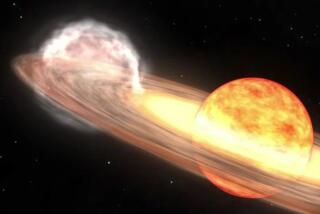NASA video shows ‘graceful’ solar flare in action
- Share via
A solar flare flashed on the turbulent surface of the sun last week – and NASA captured the moment in a video. The agency’s Solar Dynamics Observatory watched as balletic lines of light swirled and grew to produce the M-class flare.
Solar flares get letter grades to categorize their strength. The weakest ones are A-class; then come B, C, M and finally X class. Each letter class is 10 times stronger than the one before it. Numbers attached to each letter put a finer point on each flare’s power. The M6.5 flare that peaked on April 2 at 7:05 a.m. was a mid-level flare that, if aimed at Earth, probably wouldn’t have caused a whole lot of trouble.
“M-class flares can cause brief radio blackouts at the poles and minor radiation storms that might endanger astronauts,” according to NASA.
The really worrisome flares are X-class solar flares, which are often accompanied by a coronal mass ejection – an enormous eruption of charged particles that the sun hurls into space. If an X-class flare and an associated eruption are aimed at Earth, such “solar storms” can trigger extended onslaught of radiation that can damage satellites, communication systems and power grids.
Solar flares are not yet entirely understood; these flashes are caused by a complex process that involves the reconnection between magnetic field lines on the surface.
“A flare is the sort of close-to-the-surface phenomenon where the twisting and snapping occurs and therefore you get all this heat and kinetic energy,” Holly Gilbert, a heliophysicist at NASA Goddard Space Flight Center says in a Q&A on what’s called “space weather.”
While the imagery in the video can be beautiful, such information from NASA’s Solar Dynamics Observatory also helps scientists to understand the movements on the sun’s surface that lead to these dramatic, sometimes violent outbursts.
ALSO:
Saturn’s moon Enceladus may harbor a watery sea
Surf’s up? Scientists catch first alien waves on Saturn’s moon Titan
Big Bang: In major breakthrough, scientists find signs of ‘cosmic inflation’
Hallelujah! Scientist finds 19 new species of speedy, clever praying mantises







